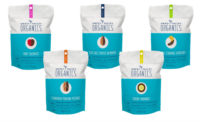Stoked!: Santa Cruz Nutritionals continues to ride a continuous wave for functional gummies.
Once known as Harmony Foods, this epic company is cashing in on functional confections, and looking ahead and over-the-counter-remedies next.

(From l. to r.) Santa Cruz Nutritionals' Michael Westhusing, Mark Wobken, and Doug Hopkinson.

A worker inspects multivitamin gummies as they head toward packaging.

Although Santa Cruz Nutritionals primarily manufactures nutraceutical confections for other companies, it does occasionally produce items under its own brand, such as this line of Fiber Advance gummies.

Tim Nash, mogul specialist, checks on the newly installed Tanis Confectionery kitchen, which enables functional ingredients to be added after the cooking process.


Fortified gummies undergo sanding.

Fortified gummies then are inspected before being conveyed toward packaging.



A worker monitors scaling of gummies going into a bulk carton.

TNA form/fill/ seal baggers, which were installed more than 20 years ago, continue to play a key role in packaging for the company. A new generation of TNA baggers were recently installed to handle increased output.

An automated starch tray system feeds moulds to the starch moulding line.

There are six drying rooms where products cure between 18 and 24 hours.

After drying, these fortified gummies are loaded onto a conveyor for inspection and final packaging.


Mark Wobken (left), v.p. of operations, and Felipe Romero, director of operations, review the bottling line's performance for the day.

Filled jars with gummies head toward a lidding machine.

Weight checks are performed regularly during the filling process.

Everitt Johnson, QC lab technician, gets set to test products from the plant. Additional equipment recently purchased will expand the lab's testing capabilities.



















A surf board still hangs in the executive offices of Santa Cruz Nutritionals (SCN). Not only is it a testament to the company’s namesake city — there’s a historical plaque describing three Hawaiian princes introducing surfing to California and Santa Cruz at the city’s Surfing Museum — it’s a reminder of the days when the founders of Harmony Foods (now SCN), actually surfed.
Today, there’s no time to for a “Surf’s up!” call. The executive team at SCN is too busy meeting the demand for vitamins and dietary supplements in gummi form. How busy? Well, for the past nine years, the compound annual growth rate (CAGR) at SCN has been more than 30 percent.
As Michael Westhusing, SCN’s ceo, points out, “More than 70 percent of children’s supplements are gummi based. In 1997, there were zero gummi products.”
The surge in demand for children’s supplements has also stimulated activity in the adult supplement category. Today, about 7 percent of all adult dietary supplements are in gummi form. Recent projections foresee continued expansion as older consumers turn to gummies for fiber, vitamins and other supplements.
“We’re seeing ‘pill fatigue’ amongst certain consumers,” explains Westhusing. “Also, some adults have difficulty swallowing pills. Plus, with a gummi, there’s no need for water.”
Currently, the vitamins, minerals and supplements category represents a $10-billion segment, with an annual growth rate ranging between 3 and 5 percent. Gummies within that segment have been growing at a 10 to 12 percent rate.
Thus, SCN’s positioning has been spot on. But as with all overnight success stories, the company has been building toward this for several years now.
It all goes back to the mid 1990s, when then Harmony Foods, which was producing primarily trail mixes, gummies and snacks, was approached by two emerging entrepreneurs about co-manufacturing gummi supplements , says Doug Hopkinson, executive v.p. of sales and R&D.
“Initially, it was very difficult to incorporate bad-tasting active ingredients into gummi formulations,” he explains. “Thanks to our R&D group, the company was a pioneer in the functional gummies segment, developing flavor systems and masking agents.”
In 1998, the company came out with multi-vitamin gummies. Four years later, it was one of the first confectionery companies to be organic-certified. The following year (2003), it began manufacturing sports nutrition products. And in 2005, it was one of the first to successfully develop gummies containing Omega -3, that is, fish oil.
Hopkinson chuckles at the fish oil reference.
“We initially used actual fish oil, which stunk up the entire facility,” he says. “It took us awhile, but we finally found a supplier who could provide us fish oil in a powdered form.”
Given all the effort put into research and development, it’s no surprise that SCN maintains ownership of the intellectual property.
“All the formulas are ours,” says Westhusing. “It’s a big part of the value of the business and reflects our expertise in being able to mask flavors.”
For example, caffeine is a very bitter active ingredient in its pure form, explains Hopkinson. Used in sports nutrition products, it initially also proved tricky to mask in a gummi. SCN figured it out.
Of course, developing products represents only one element in being a manufacturer of fortified gummies. Complying with government regulations, regulations that parallel pharmaceutical requirements, also comes into play.
“About five years ago, the government initiated regulatory changes for all vitamin, mineral and supplement manufacturers that were much tougher than before,” says Westhusing.
Known as 21CFR-part 11, the registration and licensing process involves visits from the Food & Drug Administration (FDA) to ensure compliance.
“It certainly acts as a barrier to entry,” the company’s ceo admits. SCN, by the way, has had the FDA inspect its manufacturing operation twice, the most recent being last year in November. Each time the company passed the audits without any 483 notifications, that is without any additional comments.
Today, the company produces a broad range of gummi vitamins and supplements for many leading companies in the category. Moreover, thanks to the development of a new cooking process designed to accommodate nutraceuticals, one that enables incorporation of the active ingredients after the cooking process, the possibilities of additional supplements as well as over-the-counter (OTC) products has significantly increased for CSN.
For example, the company is working on incorporating probiotics, that is live cultures, into gummies.
“The starch moulding manufacturing process does present some challenges,” says Westhusing. “And encapsulation isn’t always the answer. With the new cooking process, we can take heat-sensitive active ingredients and dose them into the gummi formula using a post-cook method.”
Consequently, in addition to gummies having probiotics in them, consumers can expect to see gummies containing actives related to eye health as well as supplements benefitting hair, skin and nails.
“We looking at gender specific as well as senior formulations,” adds Hopkinson. For example, prenatal vitamins in gummi form are in the works.
Presently, about 70 percent of the company’s output, which exceeds 60 million lbs. annually, involves gummi production. The remaining 30 percent involves sports nutritional and organic products.
Late last year, the company installed a Tanis kitchen featuring post-cook dosing as well as a new NID starch moulding line, both of which increased manufacturing capacity by 60 percent. To help accommodate the increased output, SCN also purchased the latest generation of TNA form/fill/seal baggers.
The multimillion-dollar investments not only addressed a capacity need; it also allows the company to follow through on new product development requests from its customers. As Westhusing explains, many of SCN’s customers work closely with the company’s R&D group, which encompasses 14 people. With about 100 customers representing 300 SKUs, that’s quite a workload.
As a result, SCN invested millions in new lab equipment, expanding its ability to do more in-house testing versus third-party assays. The move will speed up R&D testing, allowing the company, to turn the spigot wide open for new product development.
“We hold regular innovation meetings,” explains Hopkinson. As a result, the five-person task force evaluates about 250 concepts annually, with about 120 launched every year. Products can take anywhere from six months to two years to launch, taking into account laboratory development, plant trials, real time stability testing and regulatory compliance.
There’s even discussion of putting in a special pilot line to facilitate plant trial testing, Westhusing says, although that still hasn’t been determined yet. In the interim, the focus in manufacturing — now that capacity issues have been resolved — is on improving efficiencies.
Mark Wobken, v.p. of operations, joined SCN last May. A 35-year operations veteran in regulated industries, mostly in medical devices and pharma, Wobken looks to introduce more lean manufacturing processes along with product flow systems to boost output.
“We already have a compliance and quality system in place,” he says. Despite not having worked previously in the confectionery industry, Wobken notes that “manufacturing is manufacturing. You have to make sure that you have good people who are trained to do their jobs and that the quality of the product is there to meet customer requirements. We have batch processing and a work flow process that is similar to other industries. The difference here is that you’re working with pectin and gelatin as well as with drugs and biologics.”
The application of such systems as lean manufacturing, which incorporates the 5S program (a Japanese workplace organization method), has already made a difference, he points out.
“We’ve been able to increase our bottling capacity by 20 percent,” Wobken says. “In addition, we’ve focused on improving changeover times, reducing them from 30 minutes to 15 minutes.”
Similar improvements have been registered with regards to sanitation practices, cutting downtime from four hours to two hours for major line cleaning and sanitizing. He attributes the improvements to implementing the 5S program as well as introducing checklists to ensure everyone’s focused on the completing the tasks on time and correctly.
“It’s like a pitstop crew at NASCAR,” he says, referring to changeovers. “Besides, you’re only making money when the lines are running.”
The new nutraceutical cooking kitchen is also contributing to efficiencies, Wobken adds.
“As we all know, heat isn’t good in functional gummies; it tends to burn off the vitamins or supplements,” he says. “By being able to add the supplement after the cooking process, we’ve been able to greatly reduce the amount of supplement used. The yield on return is much better and we really don’t lose much in processing.”
The system will also allow SCN to enter the OTC category.
“The OTC market hovers at $50 billion,” Westhusing says. “Another manufacturer recently reported, there’s a ‘monstrous opportunity’ to deliver pharmaceutical ingredients in a gummi format. We see it as the obvious next place for this delivery format.”
At this point in time, there’s no one in the marketplace delivering drugs in such a manner. SCN looks to change that. The company is in the process of getting approval under the FDA’s 21CFR – 211 process.
“We’re looking at partnering with one of our sister companies,” he says. [Editor’s Note: RoundTable Partners, which acquired SCN on July 29, 2013, is a private equity group that works with several companies involved in the healthcare industries.] “It’s a matter of locating equipment at their facility and then utilizing some of their assets.”
As Westhusing explains, becoming involved in OTC represents a way of building “a better mousetrap. We can offer cough/cold/allergy medicines in a gummi format.”
SCN’s chief executive does, however, acknowledge that there are some challenges.
“When you look at vitamin gummies for children, we don’t manufacture a product that even in large doses can be toxic,” he explains. “Even if you eat a whole bottle of vitamins, the body will only absorb so much and the rest simply goes through your system.”
For the OTC segment, it’s a different ball game. Nonetheless, Westhusing remains confident.
“We can only enter this segment if we can provide a product that’s adult doseable,” he says. For anything to be adult doseable, it has to be child-proof.
“We’ve been working on this for nearly five years,” Westhusing says. “And we recently applied for patents for both the process and the formula.”
Cowbunga! No wonder they’re stoked at SCN.
At-a-Glance: Santa Cruz Nutritionals
Headquarters: Santa Cruz, Calif.
Sales:$200 million (Candy Industry estimate)
Employees: 325 (permanent)
Plant: 225,000 sq. ft. (three starch moulding lines)
Products: Fortified gummies, organic gummies, organic jelly beans
Output: 60 million lbs. (Candy Industry estimate)
Management team: Michael Westhusing, ceo; Randy Bridges, cfo; Doug Hopkinson, executive v.p. sales and R&D; Mark Wobken, v.p. – operations.
Looking for a reprint of this article?
From high-res PDFs to custom plaques, order your copy today!

























